Custom Games Value: Key Factors & How to Maximise Your Returns
Updated On: October 26, 2025 by Aaron Connolly
Understanding Custom Games Value
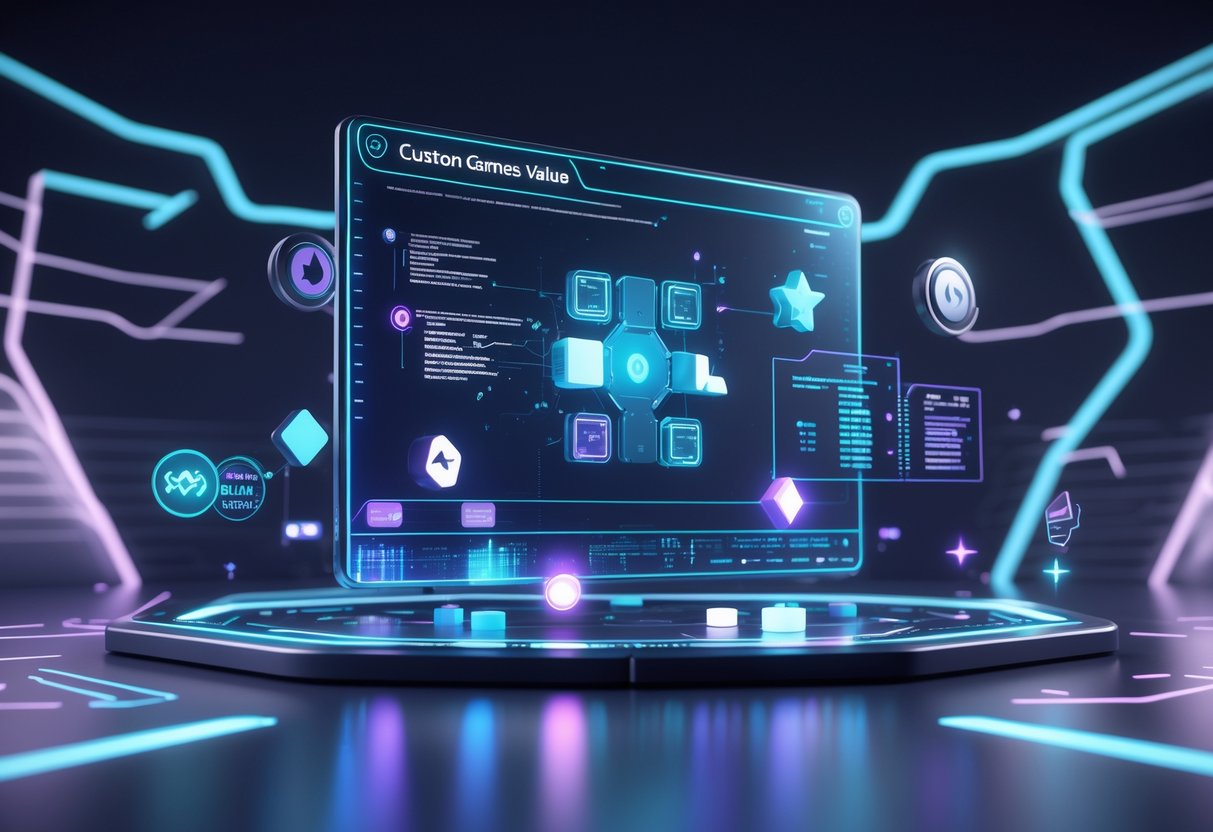
Custom games bring something different to the table. Instead of following the usual rules for mainstream titles, they get their value from originality, development complexity, and where they sit in the market—not just how many copies exist.
What Defines a Custom Game
A custom game is any gaming experience designed for a specific audience or purpose. That could mean bespoke board games, modified video game content, or even unique digital experiences.
These games stand apart from commercial releases in a few big ways. They usually target niche markets or specific groups of players.
Developers tend to focus on features that matter to that audience, rather than trying to please everyone.
You’ll usually spot custom games by these traits:
- Unique gameplay mechanics you won’t find elsewhere
- Limited production runs or exclusive access
- Content tailored to a certain group
- Higher development costs per unit
Rarity really matters here. Since you can’t just go out and buy another copy, custom games hold a different kind of value.
Why Custom Game Valuation Differs
Mainstream game value usually comes down to demand, production numbers, and brand. Custom games? They’re a whole different beast.
Here’s what actually affects value:
| Factor | Impact on Value |
|---|---|
| Development hours | High – more time, higher cost |
| Uniqueness | Very high – one-of-a-kind gets top price |
| Target market size | Medium – smaller market, higher price |
| Production complexity | High – tough builds boost worth |
Custom games tend to keep their value better than mass-market ones. Scarcity makes collectors and players take notice.
Developers can’t spread costs across millions of copies. That means each custom game has to pay for its own creation. Artists, programmers, and designers usually charge more for this kind of work.
Some custom games solve problems that standard games simply can’t. Corporate training, educational tools, or personalised experiences? Those always command higher prices.
Core Factors Affecting Custom Game Value

Three main things really decide what a custom game is worth: rarity, demand, and platform. These work together and shape how the market responds.
Rarity and Unique Features
Rarity is the heart of custom game value. If you can create something truly unique, collectors and fans will pay attention.
Short production runs make games scarce, pushing prices up. For example, a custom board game with only 100 copies out there will almost always cost more than a mass-market game. This scarcity principle works across all formats.
Unique features add a lot of value:
- Custom artwork and personal themes
- Game mechanics you can’t find in other titles
- Premium materials and bespoke components
- Gameplay tailored to a special audience
Players get more engaged when they can’t get the same experience anywhere else. When you modify a familiar game, it instantly stands out in a crowded market.
Intellectual property value can grow too. If your game’s design or style becomes recognisable, it might lead to sequels, expansions, or even licensing deals.
Demand and Market Trends
Demand sets the price people are willing to pay. If you know what your audience wants, you can position your game to sell.
Right now, board game fans look for social experiences and educational value. Companies want team-building games, while collectors chase limited editions they hope will appreciate.
Some current trends:
- People want more personalised gaming
- Companies are asking for custom training games
- Schools commission learning-focused designs
- Buyers are more willing to pay extra for quality
Prices change by audience:
- Hobbyists: £50-£200 for custom board games
- Companies: £500-£5,000 for training games
- Schools: £200-£1,000 for classroom sets
Timing is huge. Games released at Christmas or during summer holidays—or those tied to hot trends—usually fetch higher prices.
Platform Influences
The platform you choose affects costs and revenue potential. Each one brings its own pros and cons.
Physical board games need more upfront investment, but often have better profit margins per copy. Manufacturing costs range from £10-£50 depending on what you use.
Digital games can reach a global audience and cost less to produce. Custom mobile games might cost £5,000-£50,000 to make, but you can earn ongoing revenue through app purchases or subscriptions.
Hybrid games—those that mix physical and digital—can charge more and keep players engaged longer.
Your distribution channel matters. Selling direct keeps your margin high, but retail partners can get your game to more people (at a lower profit per unit).
Platform stability is important. Games made for established systems stick around longer than those tied to new tech that might vanish.
Assessing Condition and Completeness

The state and completeness of your custom games have a big impact on their value. A mint, complete-in-box title might be worth three times as much as a loose, worn cartridge.
Grading Game Condition
We usually judge game condition using a simple three-level system. Collector grade means almost perfect, with barely any wear—great for serious collections.
Gamer grade covers average items with some minor flaws. You might notice small scratches or faded labels, but nothing major.
Budget grade is for heavily used items that still work. These could have big scratches, yellowing, or missing stickers. They’re a good fit for people who just want to play.
Condition grading never affects whether the game works. Everything should function, no matter how it looks. This helps buyers know what to expect.
Complete in Box (CIB) Explained
Complete in Box means everything that originally came with the game is still there. Usually, that’s the game itself, the original case or box, manual, and any inserts like maps or guides.
CIB usually includes:
- The game cartridge or disc
- The real case or box
- The instruction manual
- Any gameplay inserts (maps, reference cards)
CIB doesn’t usually include:
- Generic promo inserts
- Used digital codes
- Sleeves or dust covers
- Packing foam or fillers
Modern games often skip manuals. That’s normal—if there wasn’t a manual to start with, it still counts as complete. Always check what was standard for your game and region.
Impact of Missing Cases and Manuals
Missing parts can really lower value. A complete game might sell for 40-60% more than a cartridge alone. Sometimes, just the manual is worth 15-25% of the total value for retro games.
Game only means just the cartridge or disc—no box, no manual. These work fine but don’t appeal to collectors.
Game and manual (no case) sits somewhere in between. The manual keeps some collectible value, but missing the case hurts display potential.
Cases matter more for disc games than cartridges. CD and DVD games without cases are harder to protect, so the box is worth more for those.
Using PriceCharting for Accurate Valuations
PriceCharting pulls real eBay sales and marketplace data, so you get actual prices for custom games—not just guesses. You can scan barcodes, check different conditions, and see price history in one spot.
How PriceCharting Works
PriceCharting tracks what games really sell for. It grabs data from eBay’s sold listings and its own marketplace.
Their system weeds out fake listings, reproductions, and weird one-off sales that could skew the numbers.
The site sorts games by condition automatically. You’ll see prices for loose, complete, and sealed copies.
Handy features:
- Real-time tracking from real sales
- Filters out dodgy listings
- Price charts showing trends
- Quick barcode scanning
They update the site often, so you’re looking at current prices—not old info.
Comparing Custom Listings
When you check custom game values, you have to compare similar items. PriceCharting lets you filter by condition and what’s included.
Look for games with similar mods or custom touches. A custom-painted GameBoy cart won’t line up with standard retail prices.
Try these steps:
- Search the base game first
- Match the condition to your item
- Focus on recent sales, not old ones
- Factor in custom work separately
Custom games often land between normal categories. A reproduction is usually worth less than an original. A well-modded console could fetch more than a stock one.
If you spot a custom game listed as original, you can flag it so the data stays accurate.
PriceCharting for CIB and Loose Games
Complete In Box (CIB) games always cost more than loose ones. PriceCharting shows this with clear categories.
CIB means:
- Game cartridge or disc
- Box in decent shape
- Manual
- Any extras
Loose means just the game—no extras.
The price jump can be huge. A loose NES game might be £20, but CIB could hit £80. This is key when you’re valuing a collection.
Check these details:
- Box condition – rough boxes lower value
- Manual completeness – missing pages matter
- Region – PAL and NTSC prices can differ
For custom games, think about whether mods count as “complete.” A custom case might not be original. A modded console can’t be called “brand new,” even if unused.
When in doubt, pick the lower condition to avoid overpricing.
Researching the Market Value of Custom Games

To get a real sense of what your custom game is worth, you need to look at actual sales and keep an eye on market trends. The best way is to check completed eBay sales, track price changes, and watch for demand.
Checking eBay Sold Listings
eBay sold listings show what people really pay for custom games. You can filter searches to show only completed sales, not just what’s currently listed.
Look for similar games in similar condition. Custom board games often sell for £50-200, depending on how complex they are and what’s included. Check a few sales from the last 90 days to spot any trends.
Notice the difference between auctions and buy-it-now. Auctions often reveal what buyers are willing to pay, while fixed prices might sit unsold. Custom video games usually go for £20-150 for indie releases.
Tip: Use specific search terms like “custom board game” or “handmade game.” That way, you avoid mass-produced stuff and see real custom listings.
Monitoring Price Changes
Game values move up and down with the seasons and what’s hot in the market. Check prices every month and note any big changes.
Custom games often spike during holidays, when people want unique gifts. Board games peak in November-December, while video games stay steady all year.
Keep a simple spreadsheet with dates, platform, condition, and price. After a few months, you’ll see patterns.
Custom games don’t usually swing as wildly as mainstream titles, since each one is unique. But big trends in gaming still affect what people spend.
Analysing Market Demand
You can spot strong demand when auctions get lots of bids, buy-it-now listings sell fast, and people talk about a game in forums.
Custom educational games stay in demand with schools and parents. Corporate training games also get steady interest from companies.
Check gaming forums and social groups for talk about custom games. High engagement means more interest in personalised experiences.
Compare your game to trending genres. Custom strategy games usually hold value better than party games, and educational games attract a smaller but loyal audience willing to pay.
Valuing NES and Retro Custom Games
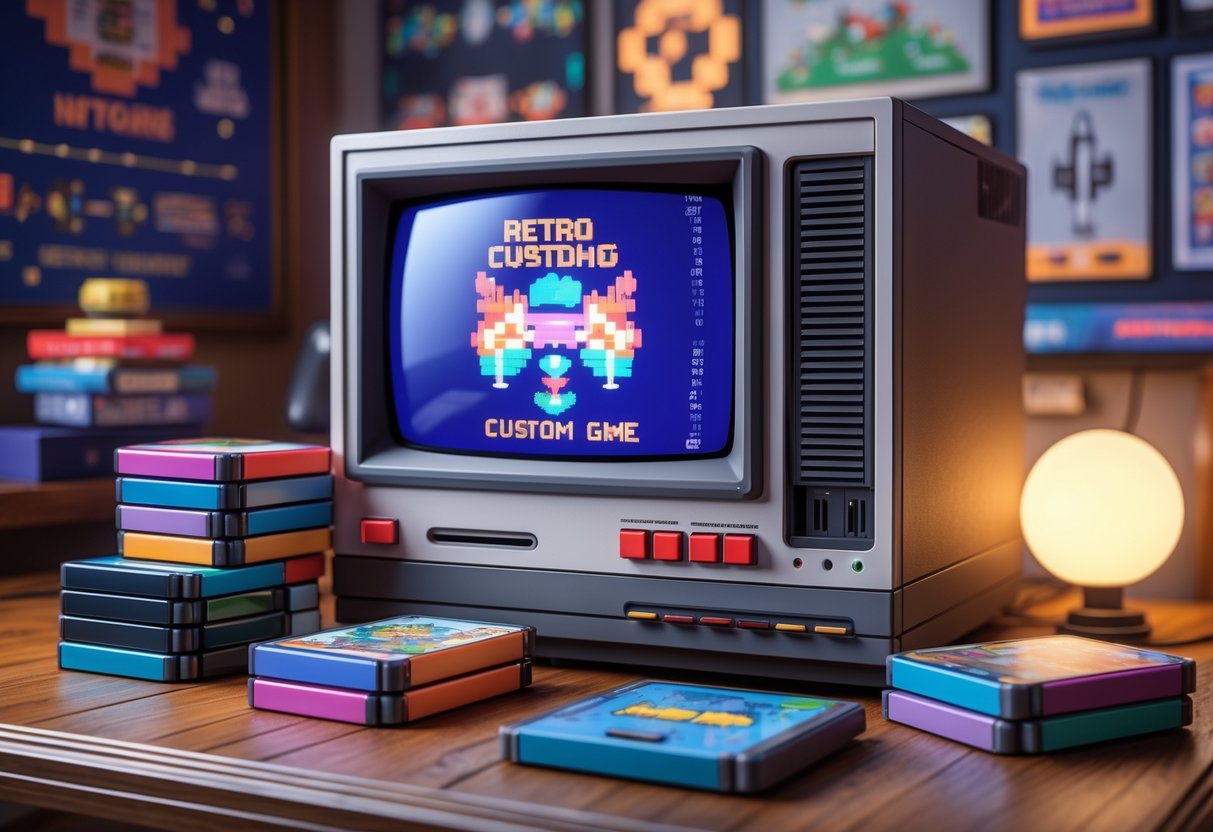
NES custom games can be worth more than you’d expect, especially limited releases that disappeared from store shelves ages ago.
The market has moved on from basic ROM hacks. These days, original homebrew titles and Kickstarter editions still fetch solid prices.
Key NES Titles With High Custom Values
The Incident really stands out as one of the priciest custom NES games out there.
Collectors have paid face value or higher for copies since physical sales stopped.
Battle Kid sold tons of copies back in its heyday.
You can’t buy it new anymore, so collectors keep driving up demand.
We’ve noticed that Lizard Kickstarter Limited Edition versions keep their value pretty well.
The standard release sticks around, but collectors love the LE variant.
Games like American Dream, B-Wings, and Road Fighter just aren’t exciting buyers anymore.
These were limited Famicom releases, but interest has dropped off a cliff.
Simple pirate releases have fallen out of favor.
Collectors now want original homebrew content, not ROM hacks or unofficial ports.
Preserving Value in Retro Games
Complete-in-box condition is everything for custom NES games.
Original packaging, manuals, and those oddball extras can make a huge difference in value.
How you store your games matters a lot.
Keep cartridges cool, dry, and out of direct sunlight.
Check PriceCharting and eBay sold listings to see what your games are currently worth.
Prices bounce around fast in the custom game world.
Limited supply, not nostalgia, usually pushes prices up.
If a game is still in production, it rarely goes up in value.
Documentation proves authenticity for the valuable stuff.
Hang onto receipts, numbered certificates, or anything that shows legitimacy.
Serious collectors expect proof when you’re selling high-value homebrew titles.
Custom Game Packaging and Cases
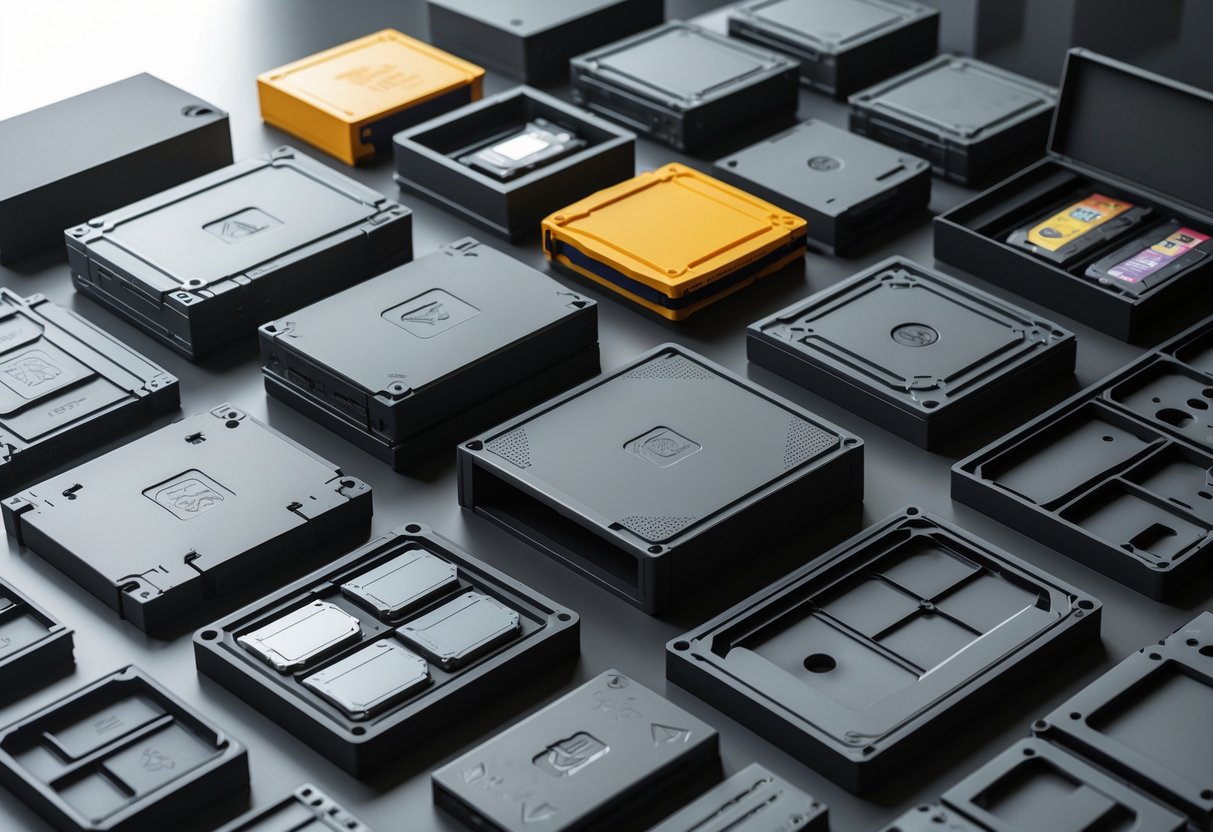
The original packaging makes a massive difference—collectors will pay a premium for complete-in-box (CIB) games.
Professional artwork and proper inserts can easily double or triple the price compared to loose cartridges or discs.
Original Versus Replacement Cases
Original cases from the manufacturer always hold more value than replacements.
Collectors spot fakes immediately.
Nintendo games drop 40-60% in value without the original box.
A loose Super Mario World cartridge might go for £15, but with the box and manual, it can fetch £35-45.
PlayStation and Xbox titles follow similar rules.
Original cases have unique logos, rating symbols, and plastic you just can’t fake.
Replacement cases are fine for your own shelf, but they kill resale value.
We’ve seen rare games drop from £200 CIB to £80 with reproduction packaging.
Key warning signs of replacements:
- Plastic color or texture feels off
- Rating logos don’t match
- Spine label print quality looks cheap
- Wrong case size
Even if your original case is beat up, keep it—restoring is cheaper than replacing.
Artwork and Inserts’ Impact on Value
Manual booklets and promo inserts can really boost a retro game’s value.
A lot of collectors won’t even consider a game without all the paperwork.
RPGs and strategy games especially need their original manuals.
Games like Final Fantasy or Civilization just aren’t the same without guides—missing manuals can slash value by 30-50%.
Promotional materials add even more:
- Registration cards (even blank)
- Posters
- Soundtrack CDs
- Developer newsletters
Condition matters a ton.
Crisp, clean manuals pull top dollar.
Water stains, rips, or heavy creases can wipe out the bonus entirely.
Store manuals separately from cases to avoid spine damage.
Protect valuable manuals in sleeves—a mint Chrono Trigger manual alone can add £40-60 to the game’s value.
Tools and Software for Game Valuation

You’ve got plenty of digital tools these days to track and value your game collection.
Barcode scanners and fancy AI-powered systems can save you hours.
Modern collectors get real-time pricing and automated valuation tools that make life easier.
Overview of Online Value Tools
PriceCharting is probably the most trusted source for game values in the UK and worldwide.
They track sold listings across different marketplaces to keep their pricing data accurate.
The site updates prices daily and breaks them down by condition—loose, CIB, or sealed.
That level of detail helps collectors know exactly what their stuff is worth.
Most people just use PriceCharting’s website.
You can search for a single game or browse by console to see price trends.
Their database covers thousands of games, from old Nintendo cartridges to the latest PlayStation releases.
They even include regional variants and special editions.
Other useful tools include MYNTY’s price aggregator and various mobile apps that tap into pricing databases.
Some of these focus on specific regions or game types.
Automated List Valuers
List valuation tools let you price out your whole collection at once.
Serious collectors save a ton of time this way.
PriceCharting’s List Value Automator works for games, cards, comics, and other collectibles.
Just paste in your list and get instant values.
This is super handy for eBay lots or Craigslist finds when you need a quick value check.
Make sure all the games are from the same console for the best results.
Some collectors use these tools to figure out fair offers when buying collections.
It’s a good way to avoid missing hidden gems in big lots.
CLZ Games also offers this feature on their web and mobile apps.
You can even scan barcodes for fast data entry, and everything syncs across your devices.
Image Analysis for Pricing
AI-powered valuation tools are the latest thing in game pricing tech.
These tools can ID games from photos and spit out value estimates right away.
RetroValuator uses machine learning to spot games, consoles, and accessories from images.
It works especially well for retro stuff where condition matters most.
Game Valuer takes a similar approach, focusing on identifying physical game media.
These tools are great for quickly sorting through big, messy collections.
Just point your phone and get instant pricing.
AI tools are fastest and most accurate with common titles and clear photos.
If you have rare games or damaged stuff, you’ll still need to double-check with traditional pricing sites.
Selling and Trading Custom Games Safely

When you’re selling custom games, stick to trusted platforms and set fair prices.
That protects everyone from scams.
A little research and some honest descriptions go a long way toward avoiding disputes and building good trading relationships.
Best Platforms for Sales
eBay is still the go-to marketplace for custom games.
They offer buyer protection and keep detailed transaction records.
Always use the “sold listings” filter to check what similar games actually sold for.
That’s real market value—not just what sellers wish they could get.
Facebook Marketplace is solid for local deals.
You can meet up, skip shipping, and keep things simple.
Gaming forums like Reddit’s r/GameSale are great for connecting with collectors who know custom game values.
These communities usually have strict verification rules that help weed out scammers.
Steam’s Community Market is best for digital stuff and trading cards.
They handle transactions and just take a small cut.
Quick tip: Check seller ratings and read reviews before you list.
Bigger platforms mean more buyers, but also more competition.
Setting the Right Price
Look up similar custom games on eBay and PriceCharting to get a baseline.
Custom games usually sell for 20-40% less than official releases because of authenticity worries.
Condition really matters:
- Mint: Ask full price
- Good: Knock off 15-20%
- Poor: Drop 40-60%
Rarity and demand can push prices higher.
Limited custom runs or games tied to big franchises are worth more.
Mass-produced homebrews don’t hold value as well.
Be upfront about your game’s custom nature.
Buyers appreciate honesty, and hiding details just leads to returns or bad feedback.
Pricing strategy: Start about 10-15% above what you hope to get.
Most buyers want to haggle, especially with custom stuff where authenticity is a question.
Avoiding Common Pitfalls
Don’t try to pass off custom games as official releases.
That breaks platform rules and hurts your reputation.
Label your listings with “custom,” “homebrew,” or “reproduction” right in the title and description.
Protect yourself from scammers:
- Get paid before shipping
- Use tracked delivery
- Keep all transaction records
- Be wary of buyers with zero feedback
Watch out for red flags like buyers asking for immediate shipping, offering more than your price, or wanting to take the conversation off-platform.
Take photos from every angle and document any flaws or custom mods.
Heads up: Some platforms ban certain custom content.
Always read the terms of service so you don’t get suspended or lose your listings.
Maximising the Value of Your Custom Game Collection
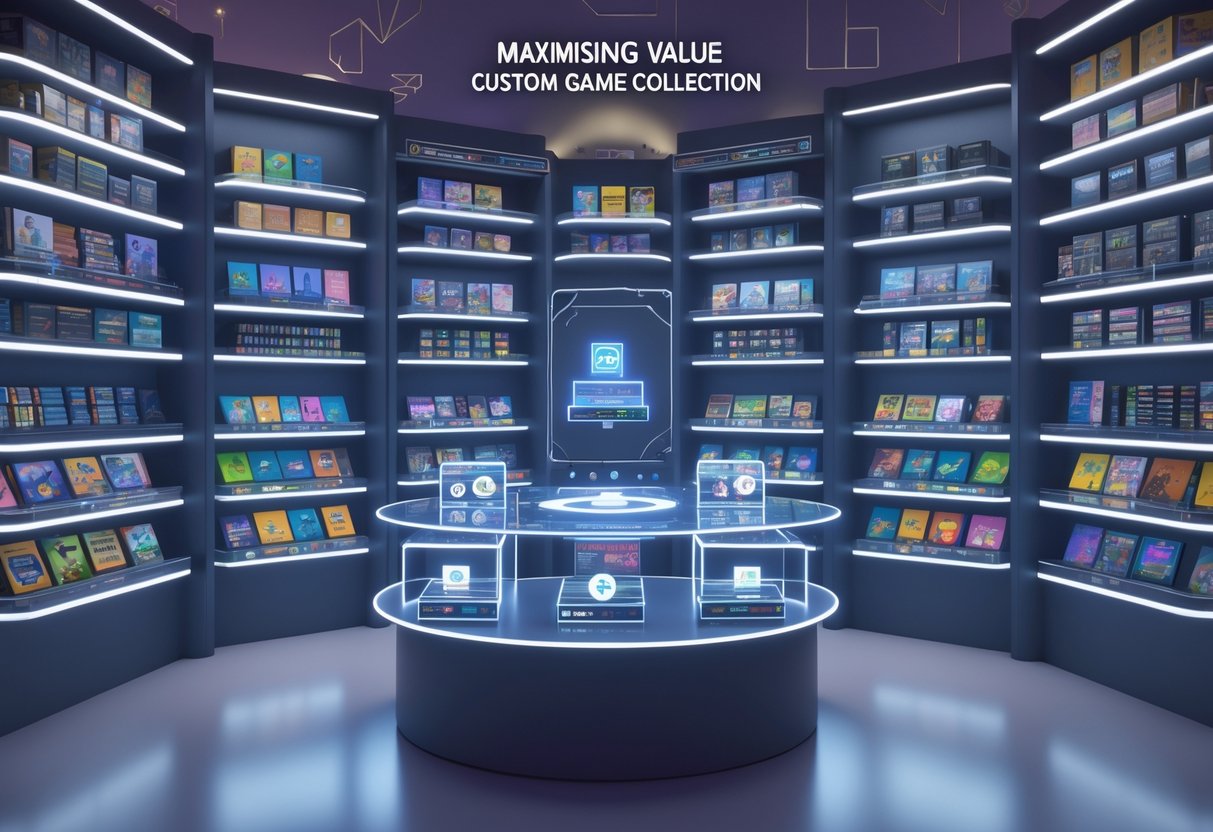
A little care and some smart selling moves can really boost your custom game collection over time.
If you understand preservation techniques, keep good records, and pick the right time to sell, you’ll get the most from your games.
Care and Preservation Tips
Treat your custom games like art if you want to keep their value.
Temperature control is key—store games at 18-21°C to stop warping or parts breaking down.
Keep humidity between 30-50%.
Too much moisture can cause mold, while too little makes things brittle.
Keep games out of direct sunlight.
UV rays will fade labels and weaken plastic over time.
Handle components gently when playing.
Use card sleeves for valuable cards, and wash your hands to keep oils off the pieces.
Store boxes upright like books, not stacked.
This prevents crushing and makes it easier to grab a game without damaging others.
Check your games every few months for damage.
Catching loose parts or small tears early means you can fix them before they get worse.
If you’re serious, set up a climate-controlled space.
A spare bedroom or a basement with a dehumidifier can work wonders.
Documenting Provenance
Keep detailed records for each custom game.
Document everything from the start—sometimes the paperwork is worth more than the game.
Write down the designer’s name, creation date, and how you got it.
Photos of the design process are a nice touch if you have them.
Save sketches, rule drafts, and any chats with the creator.
Collectors love this kind of authenticity.
Hang onto receipts and invoices to show what you paid.
That helps with insurance and resale.
Photograph components regularly to track condition over time.
Take close-ups of artwork, pieces, and anything unique.
Back up digital files in a few places—cloud and local—so you don’t lose anything.
Note any repairs or changes you make.
Being transparent about modifications keeps buyers’ trust.
Make a simple spreadsheet listing each game’s details, condition, and value.
Update every few months to spot trends in your collection.
Timing Your Sale for Profit
You can get better returns if you sell at the right time.
Holiday seasons (November-December) usually mean higher prices since collectors are shopping for gifts.
Watch gaming convention dates.
Selling before big events like Gen Con or Essen often creates a rush from collectors looking for something special.
Keep an eye on trends.
If pirates are hot because of a new movie, your custom pirate game might spike in value.
Condition comes first—don’t wait for the perfect market if your game is already in top shape.
If the designer of your game starts getting famous or wins an award, values usually go up within a year.
Economic swings matter, too.
If things look shaky, it might pay to wait until buyers feel more confident.
List games during the busy gaming seasons—autumn and winter work best.
Spring cleaning season can also bring out buyers hunting for new additions.
Case Studies: Real-World Custom Game Sales

The custom game market has pulled in some eye-opening sales numbers across all sorts of platforms and game types.
You can spot patterns in what makes people pay more for custom games if you look at the biggest transactions.
Notable High-Value Sales
Some of the most jaw-dropping custom game sales have happened on eBay, where rare gaming experiences go for surprisingly high prices.
Minecraft Custom Worlds sit at the top, with a few selling for £2,000-£5,000.
We’re not talking about simple builds—these are full games with custom mechanics, unique storylines, and months of hard work behind them.
Counter-Strike custom maps have also pulled in £800-£1,500, especially if they feature pro-level design.
Maps used in big tournaments or with clever gameplay twists usually grab the highest bids.
People have paid £3,000-£8,000 for World of Warcraft private server setups.
These setups often come with custom storylines and gameplay systems you won’t find anywhere else.
The mobile gaming sector isn’t far behind.
Customised match-three games for brands usually sell for £500-£2,000, depending on how complex they are and what licensing is involved.
Lessons from Top Transactions
A handful of factors seem to make the biggest difference in custom game value.
Development time bumps up the price.
Games that take over 100 hours to make almost always sell for more than quick mods.
Buyers seem to notice the effort in intricate systems and detailed art.
Brand integration really boosts value.
If a custom game includes well-known products or company branding, it might sell for two or three times what a generic version would get.
No wonder so many businesses want Match-3 games with their own products in them.
Platform exclusivity pushes prices higher.
Custom games built for a single platform or that need special hardware usually cost more than mods anyone can use.
Community validation is huge.
Games with active players, good reviews, or tournament history keep their value much better than those nobody’s tried.
Buyers hand over more money for custom games that solve a real problem or offer something they can’t get anywhere else.
Frequently Asked Questions
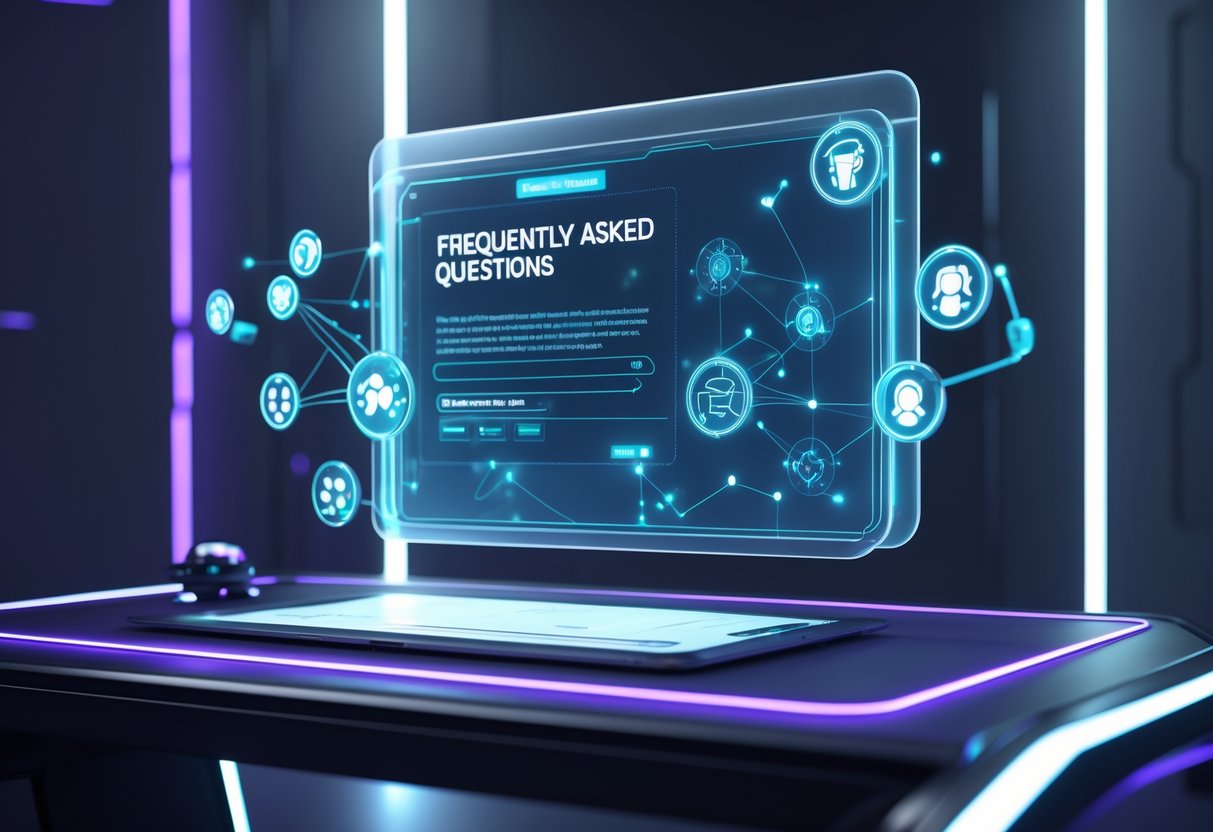
These questions tackle the financial and strategic choices you’ll face when making a custom game.
Let’s break down revenue, engagement, pricing, retention, extra services, and what really counts as success.
How can I calculate the potential revenue from my custom-built game?
Start with your production costs and the profit margin you want.
If you spend £20 making each copy with The Game Crafter, you might charge £45-50 to hit a reasonable margin.
Estimate how many copies you’ll sell in a month based on your marketing.
A well-promoted custom game can usually move 50-200 copies in its first year on Etsy or Amazon.
Don’t forget about extra revenue streams.
Expansion packs, digital editions, and merch can add 30-40% to your total revenue over time.
Keep an eye on your conversion rates—if 2-5% of website visitors buy, you’ll need 1,000 visitors to get 20-50 sales.
What strategies exist for maximising player engagement in custom games?
Build progression systems that keep players coming back.
People stick around when they can unlock new stuff or see the story unfold as they play.
Add social features that make players interact.
Games with co-op or friendly competition usually get more playtime than solo-only games.
Release expansion content on a regular schedule.
Monthly mini-expansions or big quarterly updates keep things fresh and give players a reason to return.
Set up an online community.
Discord servers, Facebook groups, or forums help players share tips and stay invested.
Playtest your difficulty curve.
Games that start easy but get deeper for advanced players tend to keep both casual and hardcore fans interested.
Could you suggest approaches to pricing custom game features?
Try tiered pricing.
Offer a basic version for £30-40, a deluxe with extra bits for £60-70, and a premium collector’s edition for £100 or more.
Price expansions at 20-30% of your base game.
If your main game is £45, expansions at £10-15 usually feel fair.
Bundle products together.
Selling your core game plus two expansions for £65 instead of £75 separately nudges people to buy more.
Look at what similar games cost.
Strategy games tend to cost more than party games, and educational ones usually fall somewhere in between.
Test prices with pre-orders or on crowdfunding sites.
Kickstarter and Indiegogo data can show you which price points get the most interest.
What aspects should I focus on to enhance the retention rate in my custom game?
Find the sweet spot between complexity and accessibility.
Games that take just 5-10 minutes to learn but offer deep strategies keep people coming back.
Mix up the setup every time.
Random boards, different starting conditions, or modular pieces help prevent boredom.
Let players make real choices.
If people feel their decisions truly matter, they’re way more likely to play again.
Create memorable moments.
Special events or dramatic twists make for great stories, and those stories get people playing again.
Offer official variants or house rules.
Giving players new ways to play can stretch your game’s life for years.
In what ways can I incorporate value-added services into my custom game offering?
Let people personalise their game.
Custom names, unique art, or special pieces often make customers happy to pay 20-40% extra.
Make a digital companion app.
Timer apps, score trackers, or bonus content through QR codes can give your game a modern edge.
Record tutorial videos or write guides.
Good instructions cut down on confusion and boost satisfaction.
Offer tournament kits or event packages.
Game shops and community centres love organised play materials—they help your game get noticed.
Set up a subscription for ongoing content.
Monthly scenario packs or quarterly expansions can keep revenue coming in and fans engaged.
What metrics are essential to track for understanding the success of custom game projects?
Keep an eye on your customer acquisition cost compared to lifetime value. If you spend £15 to bring in a customer and they end up spending £60, that’s a good sign your business model works.
Pay attention to production time from the first idea to when the game hits the market. Most custom games that succeed take about 6-12 months to develop. If it drags on longer, you might be dealing with scope creep.
Look at customer satisfaction by checking out reviews and tracking repeat purchases. Games that average over 4 stars and get at least 30% of their customers coming back usually stick around for the long haul.
Compare sales velocity across different platforms. When you look at how your game does on Etsy, Amazon, and through direct sales, you can figure out where to double down on your marketing.
If your game has online elements, watch engagement metrics closely. Things like active forum posts, digital content downloads, and social media chatter all show whether your community actually cares.

